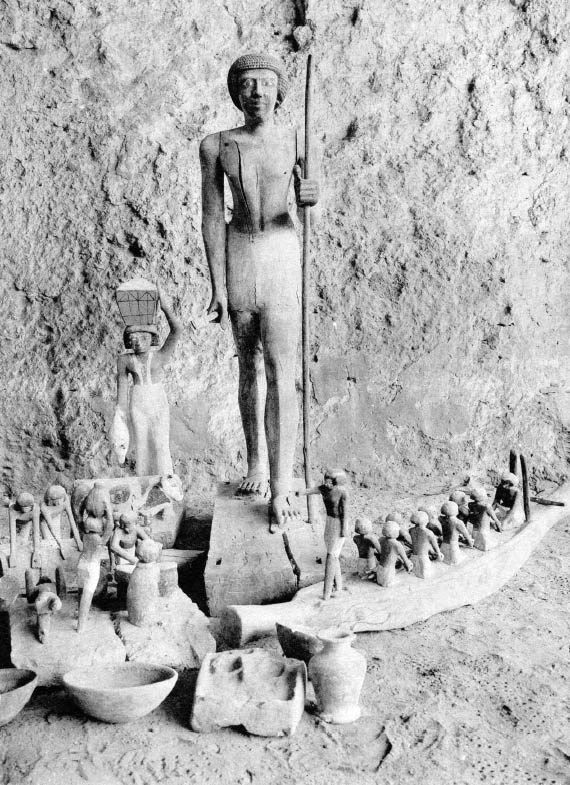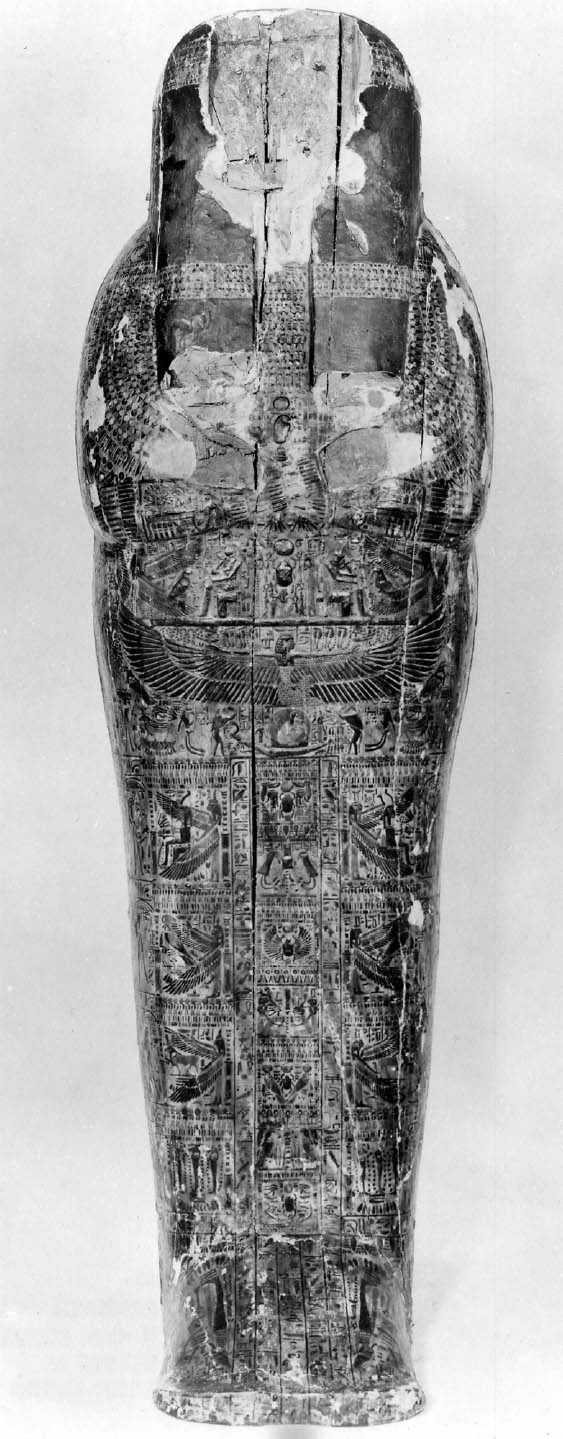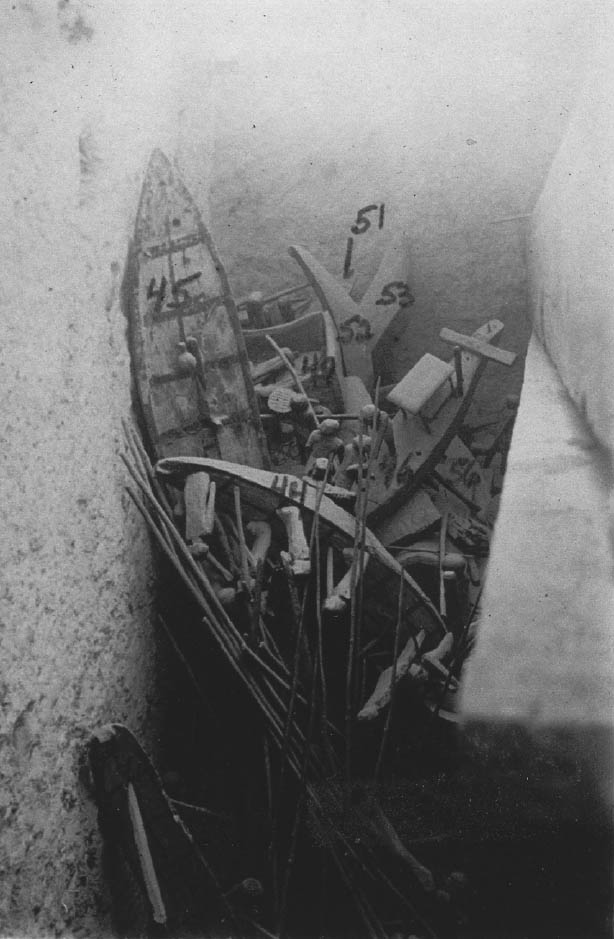THE ANCIENT EGYPTIAN COLLECTION AT THE MUSEUM OF FINE ARTS, BOSTON. PART 1, A REVIEW OF TREATMENTS IN THE FIELD AND THEIR CONSEQUENCESSUSANNE G�NSICKE, PAMELA HATCHFIELD, ABIGAIL HYKIN, MARIE SVOBODA, & C. MEI-AN TSU
8 WOOD8.1 TYPES AND NUMBERS OF OBJECTSThe typology of wooden objects in the MFA collection generally reflects the manner in which wood was used in ancient Egypt. Wood was the most commonly found material for the fabrication of coffins, but was also used for the manufacture of sculpture, tomb models, furniture, tools, weapons, and domestic objects. Although indigenous sources of wood were relatively scarce, the ancient Egyptians' creativity and economy in the use of wood, coupled with environmental conditions favorable to its preservation, left a rich legacy of highly sophisticated wooden artifacts. Most of the species available to them were of relatively small dimensions, so joinery techniques were quite sophisticated, and methods were developed for the patching or reuse of otherwise unsuitable wood. The collection of approximately 1,323 wooden objects includes 26 mummy cases and coffin panels and more than 120 polychromed wood tomb models from Bersha (Terrace 1967). Seventy-five of these are model boats, and there are examples depicting daily life such as bakeries, the activities of weavers, carpenters, beer brewing, granaries, and models of people, animals, and food. The ancient Egyptians themselves attempted to compensate for the inherent instability of the multilayered structure of polychromed wood, sometimes adding a layer of finely woven fabric between the wood and gesso layer to mitigate damage from movement of the wood. This layer can be seen in the skirt of the statue of Wepwawetemhat (fig. 11; MFA 04.1780), which was also consolidated with a thick layer of wax after excavation. While the paint remains tented, it has been well immobilized by this process. It is truly remarkable that so many wood artifacts survived thousands of years in Egyptian burials. Nevertheless, they have sustained a number of different types of deterioration, including soft rot, brown rot, fungal decay, and nonbiological forms of deterioration. Much Egyptian wood has been subjected to alkaline conditions, either through contact with limestone in tombs or by having been covered with gesso as a preparatory layer for polychromy or gilding. Even under low concentrations of alkalinity, exposure for long periods of time may cause significant damage (Blanchette et al. 1994). The presence of salts may also contribute to the deterioration of wood objects: under unstable environmental conditions salts take up and give off moisture, causing swelling and shrinkage that lead to mechanical damage to the wood (Blanchette et al. 1994).
8.2 TREATMENT IN THE FIELDAlthough the stable climate in Egyptian tombs Rathgen observed that,“as a general rule absence of moisture in the earth is essential for the preservation of organic substances, and is the cause of the splendid condition in which objects of organic material are found in Egypt. … If organic substances such as wood … have lain in the immediate neighbourhood of oxidized bronze, and are thereby saturated with copper compounds, they show a very good state of preservation, which continues after they have been placed in a collection” (Rathgen 1905, 55). Petrie noted that wood could be damaged by rot and white ants and, to a lesser degree, the presence of salts. He further noted that even if stucco seemed firmly attached to wood, the gradual contraction of the wood would cause it to fall away unless it was secured with wax (Petrie 1904). Tomb robbers were responsible for tremendous damage in tombs such as that of Djehutynakht at Deir el-Bersha, where some of the most spectacular wooden objects in the collection were found, including the Bersha coffins (MFA 20.1822; fig. 12) and the Bersha Procession (MFA 21.326; fig. 13). Difficult working conditions in the field sometimes resulted in damage to objects, in spite of the best efforts of excavators. The need to protect already fragile polychromy was of great concern. Regarding the excavation of the superb coffins from the tomb of Djehutynakht, A. Lyman Story, the MFA's registrar who oversaw the excavations at Bersha for Reisner, wrote:
Rathgen noted that wood, often found moist, should be prevented from drying by wrapping in moist cloth and gutta-percha or moist moss. He stated that cracks could often be closed up by laying them in lukewarm water. Alternatively, a plaster cast could be taken and the original object then allowed to shrink (Rathgen 1905). Lucas (1932) recommended the use of small bellows or soft camel-hair or similar small soft brushes for removing surface dust and dirt. More adherent dirt was removed with water, petroleum spirit, or alcohol with a soft brush. Wood should not be wetted unless it was hard and in good condition. If unpainted, it could be cleaned with a damp sponge. Lucas also stated that plaster should never be wetted (Lucas 1932). The water solubility of Egyptian colors was recognized, so the application of benzine with soft cloths or brushes was recommended for cleaning. Resinous or pitchlike substances were removed with turpentine mixed with benzine or ether. With reference to polychromed European sculpture, Rathgen (1905) mentioned other methods of cleaning, such as the use of copaiba balsam and ammonia, or mild soap. Such methods could have been utilized on ancient Egyptian painted wood as well. Desalination of wood that was in good condition was carried out by soaking. If fragile, immersion in a very stiff jelly (presumably gelatin) for one or two weeks was recommended, followed by heating and removal of the wood, leaving the salt in the jelly. It was further noted that the gelatin would strengthen the wood (Petrie 1904).
Objects too fragile to be lifted during excavation were coated with “superheated” wax, almost at the boiling point, which would thoroughly penetrate the wood. For dry but rotted wood, coating or immersion in beeswax or paraffin was recommended, as it was for wood with stucco in order to prevent the stucco and polychromy from falling off as the wood shrank. Petrie noted that “however firm the stucco may seem at first, the gradual contraction of the wood will make it fall away; but when once saturated with paraffin wax, this movement is stopped, and the stucco is held on to the basis” (Petrie 1904, 96). Wax was also used as a stabilizing treatment intended to protect objects from the rigors of travel. Lucas recommended that the wax be very hot and the object completely dry, and that the operation be carried out in a warm area. Small objects could be gradually immersed, prewarmed if possible, but wax could also be applied with a pipette or brush or, for large objects, poured from a can or teapot (Lucas 1932). Excesses were removed by wiping surfaces with a soft rag while the wax was still liquid, or the object was warmed by placing it near a source of heat or with a hot spatula or soldering iron. If applied over varnished surfaces excess wax was removed with petroleum spirit and soft cloth to avoid harming the varnish (Lucas 1932). Lucas pointed out that paraffin has a melting range from about 105�F to 160�F, so it softened well before it melted; therefore he recommended prior removal of lower melting point fractions to avoid later softening under conditions of high heat. However, beeswax was preferred except where light-colored objects were concerned, because it had a much more definite melting point (140–49�F). Lucas also recognized that, unlike paraffin, the surface of beeswax tended to deteriorate through oxidation or mold. Lucas described the treatment of the painted casket from the tomb of Tutankhamen, with a ground of white chalk plaster and a thin layer of varnish, which he considered to have been originally colorless but was now yellowed with age. Blisters on the plaster were filled with paraffin applied by means of a pipette or applied as wax in petroleum spirit; fragments were secured with celluloid cement, and then the entire surface was sprayed with dilute celluloid. The entire box was covered with a thick coating of hot paraffin wax. He described the difficulty of removing the varnish to see original colors because of wax coating, presuming that the original varnish should be removed (Lucas 1934). However, in the description of the treatment of the coffin of Henettawy (MFA 54.639; fig. 14), varnished with a colored resin in antiquity, Winlock described treatment in the field with paraffin, excesses of which were washed off, leaving the unaltered ancient resinous coating intact (Winlock 1942). Celluloid could be sprayed on or applied by brush. Lucas recommended celluloid in acetone and amyl acetate at 2%, which was then diluted to 1% for use. He acknowledged that the celluloid was yellow, but at 1% he felt that it imparted little color and was the best choice available in many instances (Lucas 1932). Glue, casein, celluloid, and plaster of paris were recommended as adhesives for wood by Lucas (1932). Tapioca water was also recommended for fixing colors on stucco (Petrie 1904). Rathgen (1905) recommended that moist or wet objects be placed in thin size or isinglass solution until saturated, then dried slowly in a shady place. A solution of shellac, or varnish diluted with petroleum or benzine, was then put on with a brush. Sometimes the objects were placed directly into a mixture of varnish and petroleum or impregnated with melted paraffin. The varnish and petroleum mixture was preferable as a means of impregnation if there were cracks or holes because of the ease with which the superfluous solution dripped from the wood when it was taken out. Paraffin, however, set too quickly and imparted an unnatural white appearance to the wood. Owing to the large size of the vessels that would be otherwise required, paraffin was only useful for small or medium-size objects, but when making use of varnish, one end of a large object could be placed in the mixture while the solution was repeatedly poured over the object, placing the opposite end in the solution after two or three days, repeating until consolidation was complete.
Rathgen (1905) also mentioned other methods developed by late-19th-and early-20th-century practitioners whose names became associated with particular restoration techniques. In Leiner's method,
Rathgen recommended gum-damar solution but preferred colored collodion for coating polychromed objects. Presumably the purpose of applying varnish was to stabilize flaking polychrome. In addition to celluloid, a dilute solution of damar resin (incorrectly often called “gum” damar) in benzol or petroleum spirit was recommended, as was mastic resin in alcohol or a dilute solution of bleached shellac in alcohol. These were used at about 5%, but all were slightly yellow (Lucas 1932). Rathgen also recommended isinglass or glue as preferable to damar or shellac, with the addition of corrosive sublimate or formalin (Rathgen 1905). 8.2.1 Bersha CoffinsThe tomb of Djehutynakht (fig. 15), which was unearthed in 1915, had been plundered in antiquity. The ends of the spectacular painted wood coffins had been ripped off, and mummified remains and burial
This varnish was probably a solution of cellulose nitrate. The contraction problem associated with this material was one Lucas had noted: “an excess of celluloid (i.e. either too strong or too many coats of a dilute solution) may cause paint to crack and raise up in small saucer-shaped fragments” (Lucas 1932, 42–43). The coffin pieces were boxed and sent to Cairo but were not shipped by boat to Boston until 1919 because of World War I. They were packed in cheese-cloth and cotton, with “wood wool” between the outer case and inner case. During shipment, a fire that broke out in the hold of the SS Clan Murdoch resulted in water damage to some pieces. Some artifacts were described as being “badly mildewed and covered with frost,” others “colors rubbed and dimmed.” Because of the fire, the ship was diverted to New York and the cases not opened until they got to Boston. Although they were triple-boxed, the cotton wool in which they were wrapped had become soggy and rubbed the painted decoration. Story further noted that since the wood had been dry for thousands of years, the soaking would cause it to disintegrate much more quickly than it would have otherwise (Story 1920). It was noted that an object in the shipment that was coated with paraffin had suffered no damage, even though the case housing it had been wetted. 8.2.2 Djehutynakht Funerary ModelsThe tomb of Djehutynakht contained more polychromed wood models than any other Middle Kingdom burial known to the present day. Because of the activities of tomb robbers, these were found strewn in great disarray throughout the tomb chamber and had already suffered from disarticulation, flaking, and staining. Their fragile condition is evident in photographs taken during excavation (fig. 16; see also fig. 13) and in those of the Bersha Procession published by Terrace (1967). The Bersha Procession, the most finely executed of these, was reconstructed in the field before being shipped to the MFA. Some component parts were mismatched during this reconstruction, a situation addressed during a retreatment at the MFA (Roth and Roehrig 1989). 8.2.3 Hetepheres' FurnitureQueen Hetepheres' tomb contained gilded and polychromed wood furniture including an inlaid bed, chairs, a bed canopy, a curtain box, and a gold-and silver-covered headrest. Much of the wood was in extremely fragile condition or had already disintegrated, reportedly as a result of fungal attack (Reisner 1932), leaving for the most part only gold casings or inlays to describe their shapes. The meticulous recording of dimensions and positioning of fragments in this excavation allowed for the accurate reconstruction of this suite of furnishings. Lucas was closely involved in the restoration of the furniture, and on his advice the remaining wood was consolidated with a 2% solution of celluloid dissolved in amyl acetate (Reisner 1927). It was immediately decided that accurate reproductions should be made. The reconstruction of originals and fabrication of replicas were conducted more or less simultaneously,
8.2.4 Henettawy CoffinsThe coffins of Henettawy (21st Dynasty) (see fig. 14), which were excavated by the Metropolitan Museum of Art, entered the MFA collection in 1954. Constructed from wood with plaster reinforced with superbly woven fine linen, they were elaborately painted and varnished. They suffered from water damage in the tomb, the wood having swelled and contracted and the plaster rotting in successive drenchings. They had been treated with paraffin in the field. The wax was melted almost to boiling and applied with brushes or squirted into cracks with a syringe. The plaster was described as becoming elastic and could be pushed back into contact with the wood while still warm. Because of the colored varnish, color saturation was not considered a problem (Winlock 1942). |





